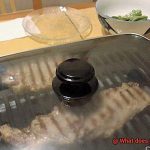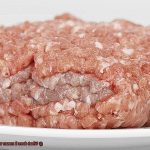Do you ever find yourself leaving food out on the counter or in the fridge for longer than you should? We’ve all been there, but have you considered the potential dangers of doing so? When it comes to chicken, leaving it out at room temperature for just four hours can lead to some serious health risks.
As one of the most popular proteins consumed by millions of people every day, chicken is a staple in most kitchens. However, its high protein content also makes it an ideal breeding ground for bacteria when left out at room temperature. This can result in food poisoning that can cause vomiting, diarrhea, stomach cramps and even hospitalization or death in severe cases.
In this post, we’ll dive into why leaving chicken out for too long is risky business. We’ll explore the various symptoms of food poisoning from spoiled chicken and provide tips on how to prevent it from happening. So buckle up and get ready to learn more about the importance of food safety when it comes to everyone’s favorite bird – chicken.
Contents
The Dangers of Leaving Chicken Out for 4 Hours
Even though it may seem like a convenient option to leave raw chicken on the counter while you attend to other tasks, this move can cause severe food poisoning.
When chicken is left at room temperature for more than two hours, harmful bacteria like Salmonella, Campylobacter, and E. coli can grow and multiply rapidly. The danger zone for perishable foods, including chicken, is between 40°F and 140°F, and leaving chicken out for four hours means it has been in this danger zone for too long.
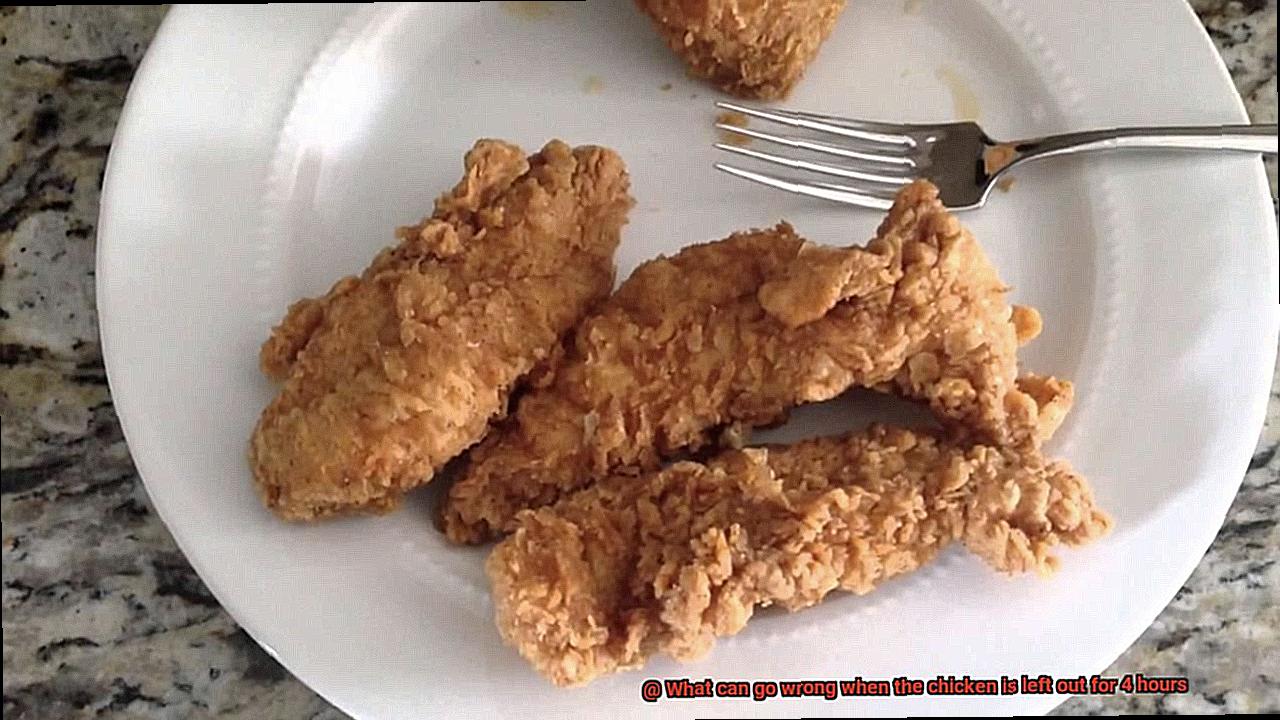
The consequences of consuming contaminated chicken are dire. Symptoms such as nausea, vomiting, diarrhea, abdominal cramps, and fever can arise. In severe cases, food poisoning can lead to hospitalization or even death.
To avoid such risks, it’s crucial to handle chicken safely from the moment you purchase it until you serve it. Below are some tips to ensure your meals are not only delicious but also safe to eat:

- Refrigerate raw chicken promptly: If you plan to cook the chicken within a day or two, store it in the fridge at a temperature below 40°F. If you don’t plan to use the chicken right away, freeze it until you’re ready to cook it.
- Cook chicken thoroughly: Make sure to cook it thoroughly to an internal temperature of 165°F. This will kill any bacteria that may be present in the meat.
- Avoid cross-contamination: Be careful not to cross-contaminate other foods or surfaces with raw chicken juices.
- Transport safely: If you’re transporting chicken, make sure to keep it in a cooler with ice packs and never leave it in a hot car or in direct sunlight.
- Serve correctly: When serving cooked chicken, keep it at a temperature above 140°F or below 40°F to prevent bacterial growth.
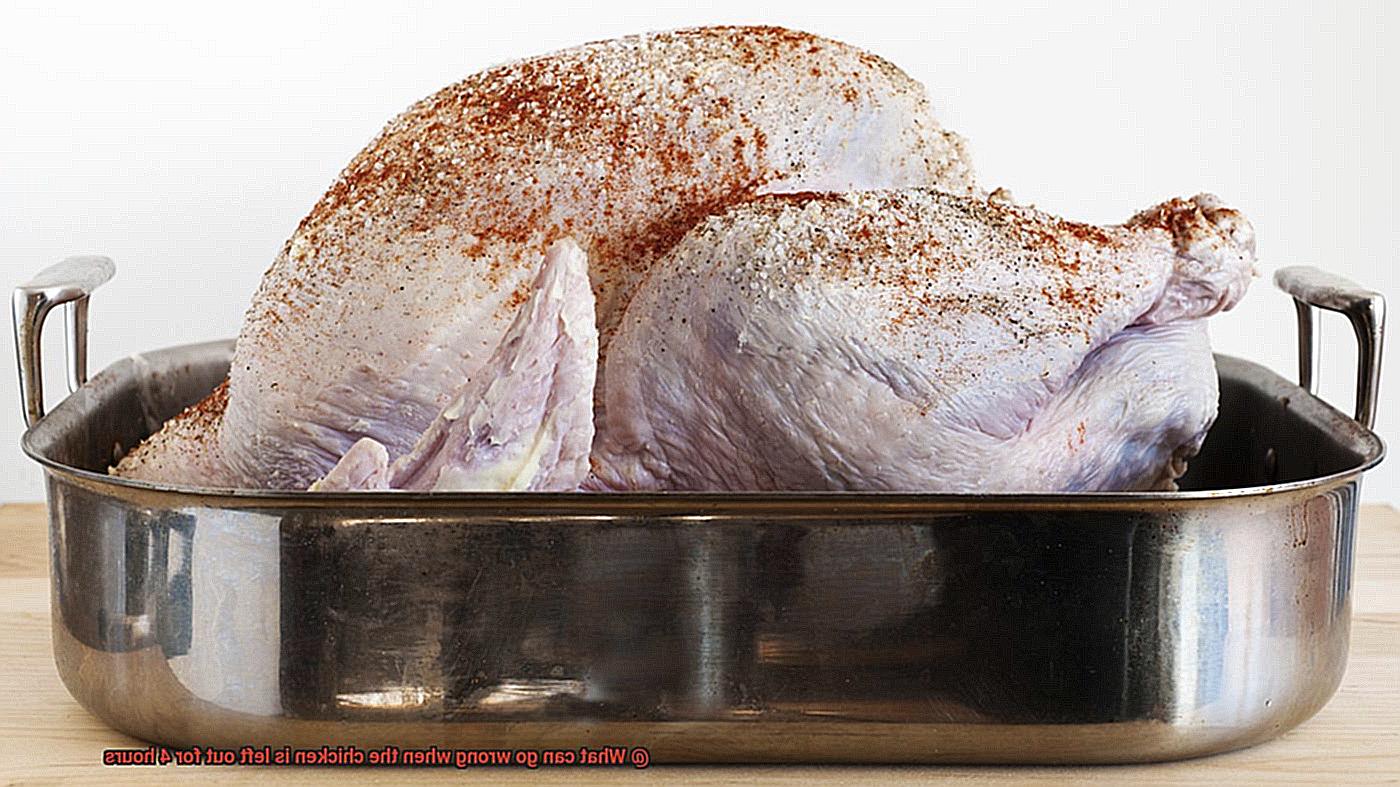
Remember that leaving chicken out for four hours isn’t the only way to contaminate it with harmful bacteria. If chicken isn’t cooked to the proper temperature or if it comes into contact with other contaminated foods or surfaces, it can also become unsafe to eat.
Risk of Salmonella Contamination
Salmonella is a type of bacteria commonly found in raw meat, poultry, eggs, and unpasteurized milk. In this post, I will delve into the risks associated with salmonella contamination and provide you with practical tips to ensure safe handling and cooking of chicken.
Let’s start by discussing the dangers of leaving chicken out at room temperature for extended periods. When chicken is left out, bacteria on its surface can multiply rapidly and reach dangerous levels. This increases the risk of salmonella contamination, which can result in unpleasant symptoms such as diarrhea, fever, and abdominal cramps. In severe cases, it can even lead to hospitalization and death.

To prevent salmonella contamination when handling and cooking chicken, here are some essential sub-topics to consider:
- Washing hands and surfaces thoroughly before and after handling raw chicken: This is crucial to avoid cross-contamination. Use hot, soapy water to wash your hands and surfaces.
- Separating raw chicken from other foods during preparation: Use separate cutting boards, utensils, and dishes for raw chicken to avoid cross-contamination.
- Cooking chicken to the appropriate temperature: Cook chicken to an internal temperature of at least 165°F. Use a meat thermometer to check the temperature.
- Storing chicken properly: Store raw chicken in the refrigerator or freezer. Keep it away from other foods to avoid cross-contamination.
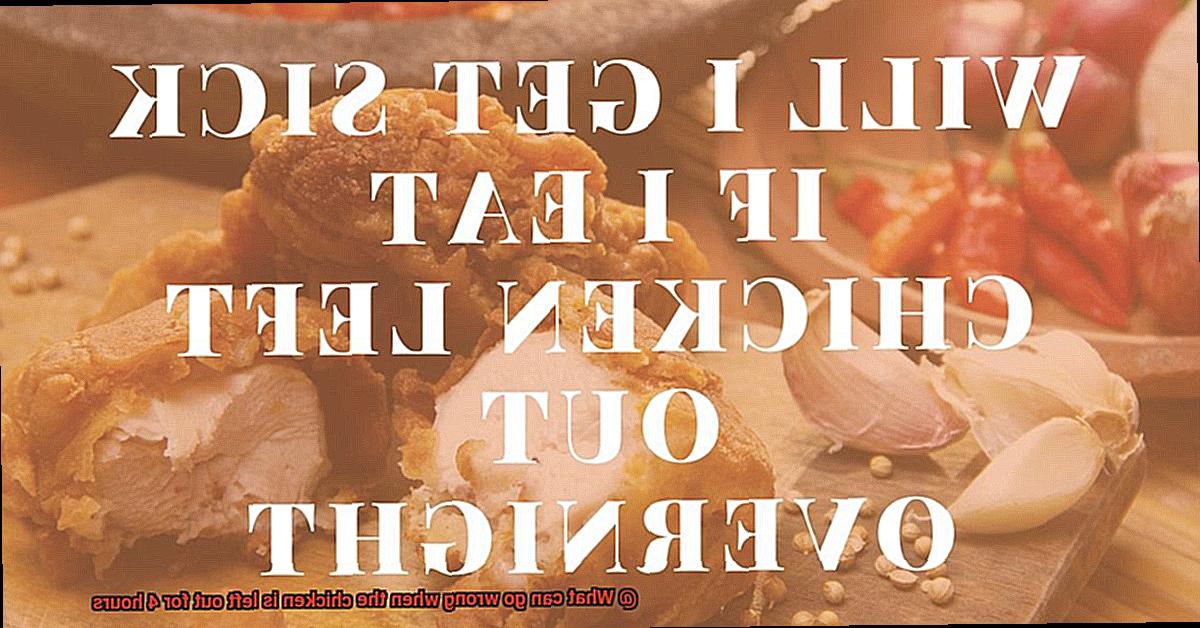
It’s important to note that even if the chicken appears normal in texture and smell, it may still be contaminated with salmonella. Therefore, it’s crucial to follow proper food safety practices when handling and cooking chicken.
Other Types of Harmful Bacteria That Can Grow on Chicken Left Out Too Long
Chicken is a versatile and popular ingredient in many cuisines, but it can also be a breeding ground for harmful bacteria when left out for too long. While most people are familiar with the risks of salmonella and E. coli, there are other types of bacteria that can grow on chicken that has been left out for too long. Here are some examples:
Clostridium perfringens
This type of bacteria is commonly found in soil and animal intestines. When it grows on meat that is not stored at the proper temperature, it can cause food poisoning. Clostridium perfringens can multiply rapidly on chicken left out at room temperature and produce toxins that can cause diarrhea and abdominal cramps within 6-24 hours after consumption.
Staphylococcus aureus
This bacteria is commonly found on human skin and in the nose. If someone who has staphylococcus aureus on their hands handles chicken, the bacteria can be transferred to the chicken. When the chicken is then left out at room temperature, staphylococcus aureus can multiply rapidly and produce toxins that can cause food poisoning symptoms such as nausea, vomiting, and diarrhea within 1-6 hours after consumption.
Listeria monocytogenes
This bacterium can cause severe illness in pregnant women, newborns, elderly individuals, and people with weakened immune systems. Listeria monocytogenes is particularly dangerous because it can grow even in cold temperatures like those found in a refrigerator. Symptoms include fever, muscle aches, and gastrointestinal distress.
Vibrio parahaemolyticus
This bacterium is commonly found in seafood, but it can also grow on contaminated chicken left out too long. Vibrio parahaemolyticus can cause food poisoning symptoms such as diarrhea, vomiting, and abdominal pain.
Other harmful bacteria that can grow on chicken left out too long include campylobacter and E. coli. These bacteria can cause symptoms such as diarrhea, fever, and abdominal pain.
How to Minimize the Risk of Bacterial Growth
Chicken is a tasty and nutritious source of protein, but it can also be a host for harmful bacteria that can cause foodborne illnesses. To keep yourself and your family safe, it’s crucial to minimize the risk of bacterial growth when handling chicken. Here are five key steps:
- Proper storage: Keeping raw chicken refrigerated until it’s ready to be cooked is essential. The temperature should be below 40°F at all times. If you don’t plan to use the chicken within a day or two, you can freeze it until you’re ready to cook. And if you’re transporting chicken from the store, make sure it stays in a cooler with ice packs.
- Cooking temperature: It’s important to cook chicken to an internal temperature of 165°F to kill any harmful bacteria that might be present. A meat thermometer is the best tool for this task because color is not a reliable indicator of doneness. Make sure you check the thickest part of the chicken, which is usually the center of the breast or thighs.
-
Good hygiene: Practicing good hygiene when handling raw chicken is essential for preventing cross-contamination and reducing the risk of bacterial growth. Always wash your hands thoroughly with soap and water before and after handling raw chicken, as well as any utensils or surfaces that come into contact with it. Use separate cutting boards and utensils for raw chicken and other foods.
- Marinating: Marinating chicken can add flavor and tenderize the meat, but it should always be done in the refrigerator, not at room temperature. Any leftover marinade that has come into contact with raw chicken should be discarded immediately because it may contain harmful bacteria.
- Storage in the fridge: When storing raw chicken in the fridge, keep it on the bottom shelf to prevent any juices from dripping onto other foods and contaminating them. Use the chicken within two days of purchase or freeze it for later use. When thawing frozen chicken, do so in the refrigerator or under cold running water.
Refrigerating Raw Chicken Promptly
This small detail can make a big difference in preventing harmful bacteria from contaminating your food and potentially causing severe illness.
To begin with, raw chicken left out at room temperature for more than two hours creates a breeding ground for harmful bacteria, such as Salmonella and Campylobacter. These microorganisms can cause food poisoning, leading to stomach cramps, diarrhea, fever, and vomiting. Refrigerating raw chicken promptly slows down the growth of these harmful bacteria, keeping your family safe and your meals fresh.
The ideal temperature to store raw chicken is below 40°F. This slows down bacterial growth and extends the shelf life of your chicken. The coldest part of the refrigerator, usually on the bottom shelf, is the best place to store raw chicken to prevent juices from dripping onto other foods. This helps avoid cross-contamination and maintains a clean kitchen.
When purchasing raw chicken from the grocery store, it is essential to refrigerate it within two hours of bringing it home. If you have been traveling with the chicken in a hot car for an extended period, it’s best to discard it rather than risking foodborne illness.
Marinating raw chicken can enhance its flavor, but it is crucial to keep it in the refrigerator at all times. Marinating at room temperature creates an environment that promotes bacterial growth and increases the risk of food poisoning. To avoid cross-contamination, use separate containers for marinating and cooking.
Here’s a summary of what you need to know about refrigerating raw chicken promptly:
- Store raw chicken under 40°F in the coldest part of the refrigerator.
- Refrigerate raw chicken within two hours of purchasing it.
- Discard any raw chicken that has been sitting in a hot car for too long.
- Keep marinating raw chicken in the refrigerator at all times.
- Use separate containers for marinating and cooking to avoid cross-contamination.
Storing Raw Chicken in the Fridge
Here are some tips to help you understand how to properly store raw chicken in the fridge and prevent contamination:
Temperature is key – The ideal temperature for storing raw chicken is below 40°F (4°C). This temperature slows down bacterial growth and prevents spoilage. Check your fridge’s temperature regularly to ensure it’s functioning correctly.
Packaging matters – Keep raw chicken in its original packaging or wrap it tightly in plastic wrap or aluminum foil. This helps prevent juices from leaking and contaminating other foods in the fridge.
Location, location, location – Store raw chicken on the bottom shelf of the fridge to prevent any drips from contaminating other foods. Consider placing a tray or plate underneath the chicken to catch any potential leaks.
Use it or freeze it – Use raw chicken within 1-2 days of purchase or freeze it for later use. This keeps the chicken fresh and reduces the risk of contamination.
Time is of the essence – Bacteria can grow rapidly if raw chicken is left out of the fridge for more than 2 hours, increasing the risk of food poisoning. Always store raw chicken in the fridge as soon as possible after purchase.
Freezing Raw Chicken Until Ready to Cook It
Freezing is a common practice for preserving meat, but it’s important to follow proper techniques to ensure that your chicken stays safe and delicious.
Firstly, let’s talk temperature. Did you know that the ideal temperature for frozen food storage is 0°F (-18°C) or lower? Maintaining this temperature in your freezer is crucial for preventing bacterial growth on your chicken. Don’t forget to double-check your freezer temperature and invest in a thermometer if necessary.
Packaging is another essential factor in freezing raw chicken. To prevent freezer burn and contamination, wrap the chicken tightly in freezer-safe packaging like plastic wrap or freezer bags. This will not only preserve the quality of the meat but also prevent any odors from affecting other frozen items.
Thawing raw chicken requires special attention to avoid bacterial growth. Never thaw chicken at room temperature as it can lead to increased bacteria multiplication. The safest method for thawing chicken is to keep it in the refrigerator, allotting 24 hours for every 5 pounds of chicken. If time is a constraint, place the sealed plastic bag of chicken in cold water and change the water every 30 minutes. In a hurry? Microwave thaw small amounts of chicken but remember to cook it right away after thawing.
y8V7kmj3T9o” >
Conclusion
In conclusion, neglecting to properly store chicken can result in serious health risks. The growth of harmful bacteria, such as Salmonella, Campylobacter, and E. coli, can lead to food poisoning that causes vomiting, diarrhea, stomach cramps, hospitalization or even death in severe cases. It’s crucial to handle chicken safely from the moment you purchase it until you serve it.
To avoid contamination and ensure safety when handling raw chicken, refrigeration is critical. Keep raw chicken at a temperature below 40°F and cook it thoroughly to an internal temperature of 165°F. Cross-contamination can be avoided by washing hands and surfaces thoroughly before and after handling raw chicken while using separate cutting boards and utensils for raw chicken and other foods.
Aside from salmonella contamination, leaving chicken out for too long can also cause the growth of Clostridium perfringens, Staphylococcus aureus, Listeria monocytogenes, Vibrio parahaemolyticus, campylobacter and E. coli.
It’s important to remember that refrigerating raw chicken promptly within two hours of purchasing it is essential for preventing contamination of other foods in the fridge. Additionally, storing raw chicken on the bottom shelf will prevent any drips from contaminating other foods. Use raw chicken within 1-2 days of purchase or freeze it for later use at a temperature of 0°F (-18°C) or lower. Safe thawing methods include keeping frozen chicken in the refrigerator or placing the sealed plastic bag in cold water with regular changes every 30 minutes.


